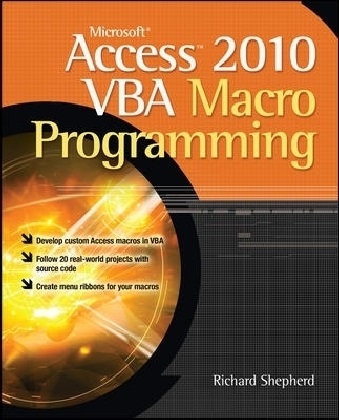Read more
Informationen zum Autor McGraw-Hill authors represent the leading experts in their fields and are dedicated to improving the lives, careers, and interests of readers worldwide Klappentext Publisher's Note: Products purchased from Third Party sellers are not guaranteed by the publisher for quality, authenticity, or access to any online entitlements included with the product. Develop custom Access VBA macros Perfect for power users, Microsoft Access 2010 VBA Macro Programming reveals how to maximize the features and functionality of Access 2010. You'll get in-depth details on Access VBA programming and application development followed by 20 real-world projects--complete with source code--that show you how to set up specific subroutines and functions. This practical resource then explains how to include the subroutines in the Access menu system and transform a set of interrelated VBA macros into an Access add-in package. Create your own Access 2010 VBA macros right away with help from this hands-on guide. Learn how to: Create and enhance forms and reportsDesign custom dialog boxes and buttonsDevelop custom menus for the RibbonUse SQL queries with VBACreate table macrosUse Office object models to interact with other Microsoft applicationsCreate and manipulate charts and graphsWork with external databasesAdd functionality to your programs with API callsAnimate objects in AccessEnhance database securityCreate audit trailsHandle large text filesTransfer data via FTP Zusammenfassung Take your database skills to the next level—develop powerful, custom Access 2010 applications using Visual Basic for Applications. Inhaltsverzeichnis Part I: Programming in Access VBA ; Chapter 1. The Basics; Chapter 2. Variables, Arrays, Constants and Data Types; Chapter 3. Modules, Functions and Subroutines; Chapter 4. Programming Basics: Decisions and Looping; Chapter 5. Strings and Functions and Message Boxes; Chapter 6. Operators; Chapter 7. Debugging; Chapter 8. Errors and the Error Function; Chapter 9. Forms and Reports; Chapter 10. Common Dialog Control; Chapter 11. Working with the Ribbon; Chapter 12. SQL Queries; Chapter 13. Table Macros; Part II: Object Models ; Chapter 14. The Access Object Models; Chapter 15. The Main Objects; Chapter 16. The DoCmd Object; Chapter 17. Using Access to Interact with Other Office Programs; Part III: Advanced Techniques in Access VBA ; Chapter 18. Charts and Graphs; Chapter 19. Working with External Databases; Chapter 20. API Calls; Chapter 21. Class Modules; Chapter 22. Animation; Part IV: Access VBA in Action ; Chapter 23. Getting the Login ID; Chapter 24. Securing Your Database; Chapter 25. Creating Audit Trails on Tables; Chapter 26. Creating and Editing Queries in VBA; Chapter 27. Search and Replace in Queries; Chapter 28. Using the DateAdd Function Chapter 29. Monitoring Table Statistics; Chapter 30. Handling Large Text Files; Chapter 31. Create and Change Table Structures; Chapter 32. Create an Objects Inventory; Chapter 33. Manipulate Charts Colors; Chapter 34. Drill Down on Charts; Chapter 35. Use Excel For Output; Chapter 36. Using FTP in VBA; Chapter 37. What Happens When the 2-GB Limit is Reached; Chapter 38. Creating Menu Structures with the Ribbon; Chapter 39. Make Controls on Forms Interactive; Chapter 40. Set Up Levels of User Security; Appendix. ASCII Character Codes; Index ...

